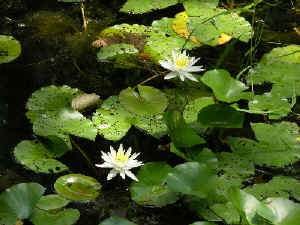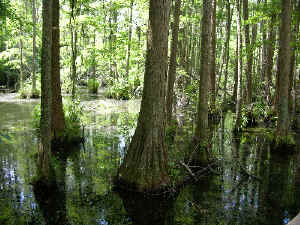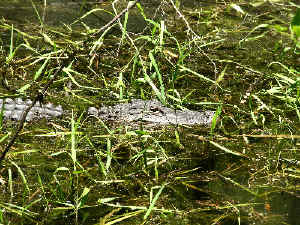ENTS,
On the road map within about five miles of my route was a site
marked
“Woods
Bay Natural Area.” I am not sure what is there but it is a
South Carolina
Park. I stopped at the visitor information booth at the South
Carolina
Border. One leaflet had it listed, but didn’t say anything
more. I could
not decide whether or not to stop. Eventually as I got nearer I
pulled off
the interstate. There was a road sign there saying Woods Bay State
Park. That
decided for me, I was going. Back a few miles on roads,
wondering if I
missed a sign or a turn-off I came to the park sign. Back a short
road was
a parking area. Nobody else was here. There was a sign
indicating there
was a two dollar fee for this day use area. I still didn’t
know what was
here, but paid the money and took my chance.

The interpretive sign explained that Carolina bays are modest
sized
elliptical depressions of unknown origins found throughout the
southeastern
coastal plain. The Woods Bay geological depression was about
1500 acres in
size. There was a visitors center at the park, but it was
closed. The
signs indicated a nature trail and a boardwalk trail. Just
beyond the
parking area was the beginning of the boardwalk. It formed a
snaky trail
extending back into a swamp about five feet wide and a foot
above the
water. No guard rails. This was what a swamp was supposed to
look like.
Bald cypress with their bold flaring bases grew out of murky
water. A
short distance down the boardwalk, lying among the swamp grass,
ten feet from
the trail was an alligator. It wasn’t very big perhaps 5 feet
long, but it
was a real alligator! Another one was behind some bushes nearby.
After
taking photos I continued down the trail. Really pretty swamp
scenes were
everywhere. The boardwalk extended a total distance of around
1000 feet
into the swamp and ended in a viewing/fishing platform. As I
started back I
could hear some other people on the boardwalk. Then a sharp
splash and a
girl squealed. One of the gators had splashed and dove into the
water. I
joined the couple and we could pick out the two gators. She said
she had
never seen an alligator in the wild before and was startled by
the movement.

There also is a nature trail here that circumnavigates an
overgrown
abandoned mill pond. The trail follows around the raised edge
of the
pond, but there is so much brush growing in the water it was
difficult to
see more than a few feet into its interior. There were signs
around the
trail describing the lizards found in the bay, anoles and
skinks, snakes,
common water snakes and water moccasins, and some of the mammals
in the
area. When I finished the nature trail a church group, I think,
had
arrived with 8 to 10 younger kids and were playing in the picnic
area. I
walked back down to the boardwalk to take some additional
pictures. I
spotted another larger alligator near the beginning of the
boardwalk, but
the two I had found earlier had disappeared.

When coming back
out the
boardwalk the group led by a adult man and a gaggle of kids were
on the
boardwalk. They ask about the alligators I had seen and I
pointed out the
one near the beginning of the trail. There were lots of oohs and
aahs, but
no one wanted to wrestle the alligator so I could get good
pictures. A
little farther back in along the boardwalk they spotted another
alligator,
probably one of the first two I had seen. The gentleman took
them to the
end of the boardwalk and had them all be quiet so they could
listen to the
sounds of nature in the swamp. They returned shortly after
having seen
some of the natural world up close and personal. This was
certainly a
worthwhile stop on my journey.
July 08, 2005 Edward Frank
---------------------------------------------
Some additional information on the Bay can be found at the
following links:
http://www.fs.fed.us/r8/fms/rec/Bays.pdf
Carolina Bays in the Francis Marion National Forest, South
Carolina
Southern USDA Forest Service, 06/11/2002
Highlights
Carolina Bays have been a source of fascination for visitors to
the
lowcountry of South Carolina since the time of their discovery.
They are
fragile and unique ecosystems: wetland habitats that exhibit a
variety of
vegetative components. Some bays are open-water depressions
dotted with
pondcypress trees and rimmed by pitcher plants and sundew. Some
bays are
thick pocosins of shrubby sweet bay, fetterbush and pond pines.
They can be
1 acre or thousands of acres. Carolina Bays are symmetrical.
They are
generally oval depressions and the long axis always runs from
northwest to
southeast. The geological origin of these wetlands remains a
mystery.
Only about 200 of South Carolina’s original 2,600 natural bays
have
remained in their pristine state. Many have fallen victim to
drainage and
clearing. There are about 25 well-defined Carolina Bays on the
Francis
Marion National Forest. The map shows some of the Carolina Bays
that can
be explored on the forest. All of the bays on the forest are
protected.
Some of the unique plant and animals to discover include:
* Amphibians
* Blueflas
* Carnivorous plants: trumpet pitcher plant and sundew
* Pond pine
* Pond cypress
* Songbirds
---------------------------------------------------------

http://www.ces.clemson.edu/scmaps/cartography/WoodsBayLitho.html
(infrared
air photo)
http://www.ces.clemson.edu/scmaps/Pages/8/Woods.htm
Of all the landforms in South Carolina that have aroused the
curiosity of
both geologists and local residents, Carolina Bays are at the
top of the
list. Woods Bay was selected as the Carolina Bay study site
because it is
the largest Bay preserved in a near-pristine condition and also
because it
is one of the most easily accessible, being located just south
of
Interstate Highway 95 on the border of Clarendon, Florence, and
Sumter
counties. In the 1920's, most of the cypress trees were logged,
and
tramways were laid over swampy areas to allow timber to be
hauled out. In
1971, logging companies were prevented from repeating the
harvest when
Woods Bay was made a state park. It contains both swampland
areas and
grassy savanna areas, as well as pine barrens along its sand
rim. A
cypress-tupelo community dominates the interior of the Bay,
while longleaf
pines cover the drier rims. Woods Bay stands in sharp contrast
with nearby
Dials Bay, which was drained for agricultural use. The park is a
refuge
for many varieties of birds, amphibians, reptiles, and mammals,
as well as
to a host of rare and specialized plants.
-------------------------------------------------------------------
http://www.southcarolinaparks.com/stateparks/parkdetail.asp?PID=216
Woods Bay State Natural Area offers a close-up look at the
unique geology
of the Carolina bays of the Atlantic coastal plain, along with
the mystery
and diverse ecology of a southern cypress-tupelo swamp.
Habitats at 1,540-acre Woods Bay also include marsh, sand hills,
oak-hickory forest and a shrub bog. More than 75 species of
mammals,
reptiles and amphibians are found here, along with more than 150
species of
birds, changing with the seasons.
Visitors enjoy canoeing, fishing, walking, hiking and
photography on the
500-foot boardwalk, canoe trail and nature trail.
Woods Bay was registered as a Heritage Trust Site in 1981 for
its
outstanding example of a Carolina bay.
--------------------------------------------------------------------
http://www.jmadden.info/WoodsBayPark/
Five pages of photo galleries
Woods Bay Natural Area, South Carolina
|